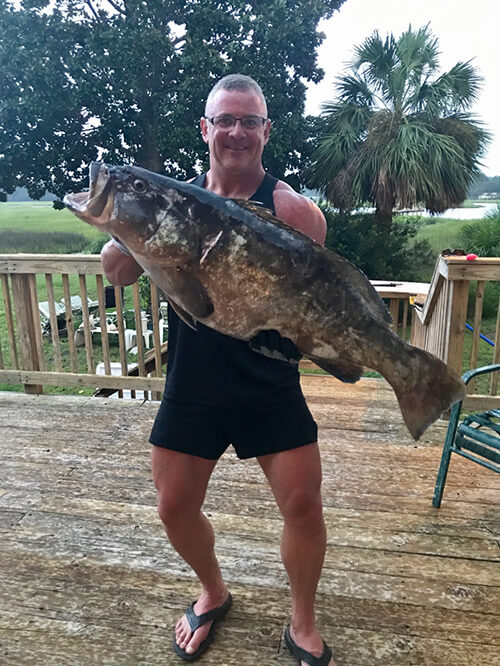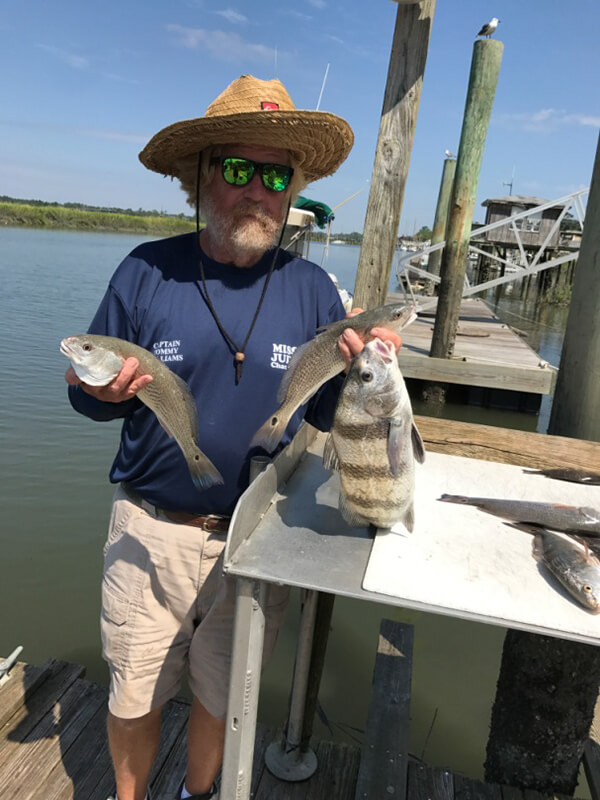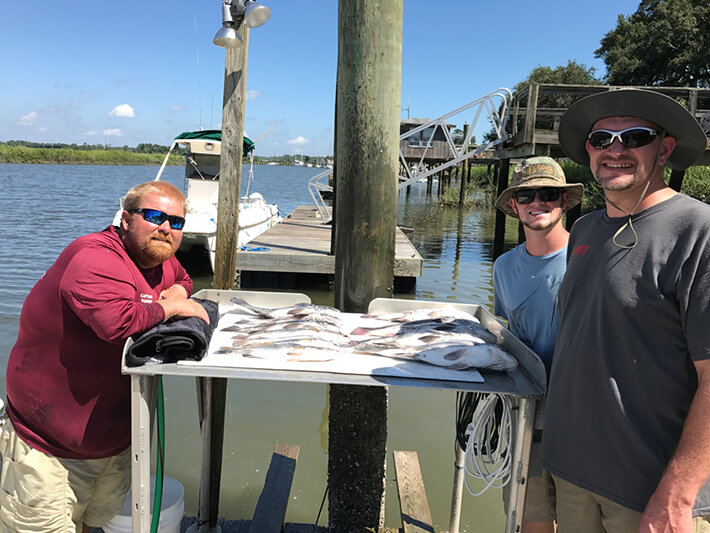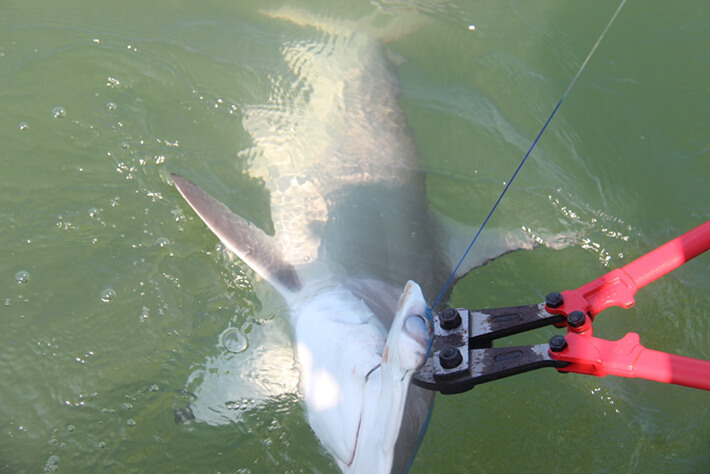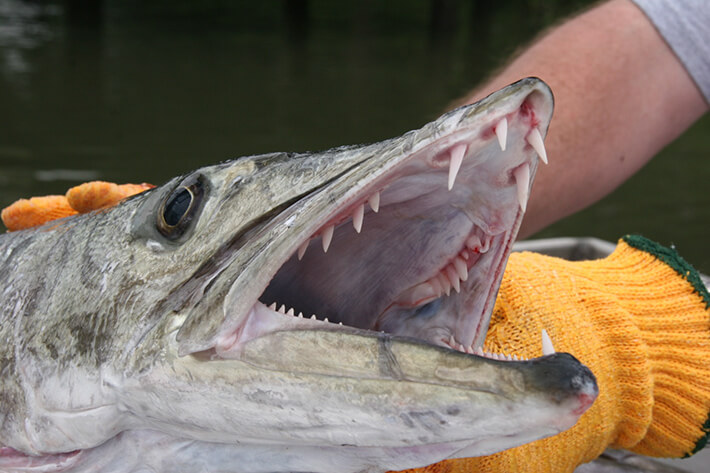September 16, 2017 – Fishing reports and a Little Miss Judy Believe It or Not story! Thanks for reading!
Fishing statement: To try to ensure that fishing stays in the hearts of those that love it!
Well, Well what do we have here? This is Captain Greg Harvey of Miss Judy Charters! He took a fisherman’s holiday! While diving in 100 feet of water at the Savannah Snapper Banks among dozens of swimming large genuine red snapper better known as sows he shot this big gag grouper! This fish was caught right before Hurricane Irma made land fall in Florida!
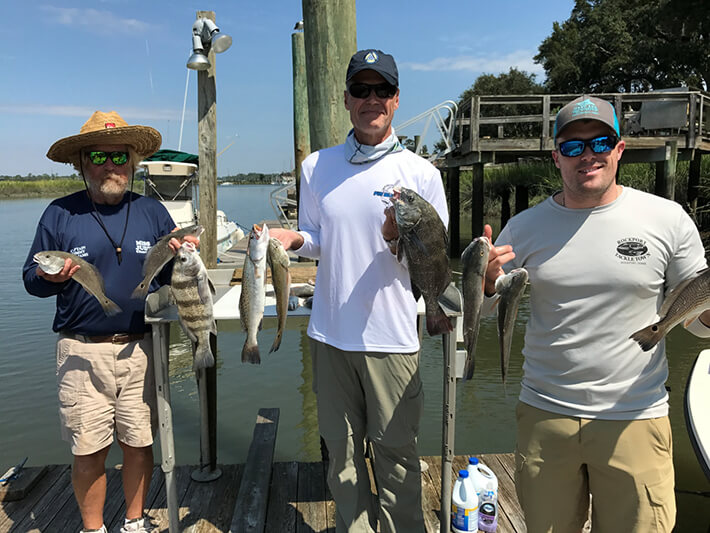
Inshore Tidbits!
What does this mean? Inshore fishermen have some pretty good catching options!
The temperatures are still hot, but there is a shuttle change that takes place in the month of September. All fish are basically put on notice that fall patterns are pending. Just the fact that daylight is a couple of minutes shorter makes all the difference to those down under. This is not the month for migrations it’s the month for feeding on everything that is available. Spotted sea trout, red fish, sheepshead, black drum, and flounder might feed at different times of the tides. However, here’s what they have in common all of them like live shrimp. The bottom line is you can serve it up anyway you like from naked with or without any sort of leader or weight, or under popping or adjustable floats. Here is the secret to the fish’s bite in September once you get the bite a-going it’s easy to change your bait. For instance: If you start using live shrimp and they all happen to die or you run out your best bet then is to change over to any leftover parts from previous hits and/or start using DOA shrimp patterns. The DOA shrimp patterns work like a charm. Here’s tip: When using pre-rigged DOAs meaning when they are purchased with hook and balance weight. I suggest removing weight and hook. Then I suggest taking a 2/0 to 3/0 Kahle hook and hooking the shrimp up like you do the real deal. Since you want the DOA to look as natural as possible you would need to place the hook in the mid ship of the shrimp. Once it’s balanced on the hook’s bend it become the prefect waving bait in the current under a popping cork or an adjustable float. The best early fall colors are Root Beer, clear gold glitter, clear chartreuse tail, and golden cherry red. I suggest using ¼ ounce jig heads for DOA shrimp patterns. (http://www.doalures.com/) Another secret is to drop a few DOA’s into the live well. I call this “adding juice appeal!”
What do we have here? Chad Ray, Captain Tommy Williams, and Dylan Ray are standing in front of the cleaning table. Both fishermen are holding
a fish full of black drum and both are from Blue Ridge, Georgia! Did they catch plenty? Yes! Did they bring them all home? NO! According to the fish tale told they did leave quite a few fins for seed! The bite was just like the show titled “Fast and Furious!” Now you know the rest of the story!
Captain Tommy Williams of Miss Judy Charters! Are the inshore biting? Yes!
Now there are other artificial baits to be considered and have been proven by the fish as well as the fishermen. There is Berkley Gulp Alive! This is where the term “secrets in the sauce” really came from. I like the 3” Shrimp Assortment recharging baits, which have new penny/natural, shrimp/pearl, and white/molting shrimp patterns all packed together. (http://www.berkley-fishing.com/berkley-bait-soft-bait-berkley-gulp/gulp-alive-shrimp-assortment/1415335.html) Heck, the best news is one pattern doesn’t work remove off hook, drop back in sauce, and grab another, it’s that simple. As far as best way to present this bait, since it looks alive is to rig it that way. (Popping corks, traditional adjustable floats, and threaded onto a jig head tied directly to your fluorocarbon leader) And there are many more shrimp patterns out there on the tackle shelves. The secret is to use the lure that you have the most confidence in, because it seems if you don’t, well bites just don’t seem to happen. My father always said, “There should be no negativity when fishing!”
For those fishermen that don’t care to use artificial baits of any kind, well you also have options. As you know live shrimp is the most preferred bait that there is and bottom line is that all fish like it. Since all fish eat it meaning all sizes from petite to large; a fisherman’s chance of catching a keeper as well as losing your live shrimp part by part is possible. There are quite a few alterative live baits that you can catch yourself. And here’s where knowing how to throw a cast net is a big plus. During this time the creeks and back of creeks are full of schooling finger mullet. They do come in all sizes from petite to larger finger mullet. I suggest keeping all sizes, because when using live bait you w
ant to match the hatch. When using larger live finger mullet as bait, your chances of a big bite is going to be less. However, when you do get a hit the fish are going to be larger, because the smaller keeper fish as well as the fetish fish will be scare off. What is a fetish fish? It is a small fish that dismantles and eats your shrimp one part at a time. The other live baits, which you could catch while casting for shrimp or finger mullet, are mud minnows, peanut menhaden, croaker, yellow tail, and basically any other small live fish.
The artificial reefs during September can be at times seemly completely baron. What does this mean, no fish bites to be had. It can be frustrating for sure, because you are marking lots of fish on your finder. And then as if someone turns on a switch the bite starts. So therefore when you arrive at selected artificial reef I suggest staying and waiting it out, because bites will happen at least eventually. When the bite is on you could find yourself catching Spanish or king mackerel and barracuda. Trolling Clark and Drone spoons will get a top water bite a going. For those fishermen that prefer trolling some real bait I suggest using medium size ballyhoo rigged on a Sea Witch. (http://www.seastriker.com/lures/lures_files/seabugs.htm) The best colors have been red/black, blue/white, and chartreuse. I prefer to rig the sea witch with my 3 hooks in a row method while using 100 pound test single strand wire as my leader. It is old school but it works. I take three 7/0 Mustad trailer hooks (J hook style with open eyes) and rig them in line. (http://www.tackledirect.com/mustad-oshaughnessy-duratin-open-eye-hooks-34091dt.html) When a fish hits this rig, the hook configuration makes it almost impossible for them to avoid getting hooked up! I suggest pulling this bait about 50 to 75 feet behind your boat. It is going to be best if you adjust your reel so that it has a medium drag. This helps in the hook up department!
As far as the bottom bite, I suggest doing a little drifting keeping your baits at mid to lower water column depth. The best bait is going to be exactly what you catch with your gold hook sabiki rig. And of course always take along a little squid. This bait works offshore as well as shrimp does for inshore fish. My favorite sabiki rig is a Tsunami Sabiki TSB-068GL-8/10 style iridescent Hage-aurora green GL head. It also has some fish skin on each gold hook, which adds yet another reason why it attracts fish. Please be responsible when discarding your bait rigs. I always dispose of mine by putting them in an empty water bottle and securing the top tight.
September Offshore Fishing Report
September for us offshore fishermen is “Snag a gag month!” This just means the grouper bite is better, because things are cooling down causing more movement. During this month all grouper such as Gags, Scamps, and Red grouper are more likely to be up and about. Best places to look for one of these fish are the live bottom ledges at the Savannah Snapper Banks. I like to call the fishing cities, which are small areas that hold all types of fish from small to large at all depths. These are basically ledges that are surrounded with sand. Best baits are going to be live cigar minnows, Spanish sardines, which can be caught with Sabiki gold hook rigs schooling over the structure at the artificial reefs. These baits are known for triggering a serious grouper bite. However, a bigger fish sometimes wants bigger bait. Baits caught at the banks are normally those fish that have air bladders such as sand perch, rock bass, vermilion snapper, pin fish, and ruby red lips also known as tomates. Before putting in live well I suggest deflating the air bladder with sharp pointed knife. These baits will also bring on big time grouper bite. For those that prefer jigging for their gags, well this would be a great time to give this type of fishing a type. I suggest using any sort of butter fly or those less expensive that “look, act, and work” like the same thing. When vertical jigging I suggest using 80 pound braided main line, 4 to 15 feet of fluorocarbon leader, and a jig (4 to 8 ounces) that has one or two hook located at top of the lure. You want your main line attached and your hooks at the same end. Jigging during this month is great because the large bottom fish start to move a little further from the protection of the ledge. The secret to perfecting this style of fishing is to keep the jig moving as erratically as possible while still imitating a bait fish that’s trying to make a solid getaway move. I love this type of fishing, because when you get a hit you are with the fish from the start to the finish!
Well, well, what do we have here? Captain Tommy Williams of Miss Judy Charters, Dylan Ray, and Chad Ray both from Blue Ridge, Georgia. What’s on the table just about to be cleaned? Spotted sea trout, black drum, and red fish!
If you really want a big big pull I suggest giving shark fishing a try in this area. While bottom fishing the Savannah Snapper Banks we have been hooking up a lot of big bulls, tigers, nurse sharks and sand bar sharks. If you are going to take one of these large sharks please check regulations before heading out. Believe me the rules can be a little confusing! As far as getting hooked up, well that’s easy, any fish that you have just caught pan size or larger bleeding (cut tail off live fish) and set out on a beefed up rig. Most
of our sharks are caught on a Carolina style rig meaning 8 ounce sinker on main line then tie on a 100 pound swivel, and then tie on leader. As far as leader I do not used any sort of wire leader instead I use 10 to 20 feet of 80/100 pound test monofilament line. To this set up I tie my 14/0 circle hook directly on to my leader. This style hook pretty insures a behind the jaws in line hook up, which means the shark normally cannot use its teeth to cut the line. Once hooked up it is suggested to keep the line tight and not in-line with the shark. The roughness of the shark’s skin will fray your leader. Always situate boat so that main line is pulling straight off shark’s head.
As far as the top water bite we have catching king mackerel near shore at the Savannah River Channel, artificial reefs, and at the Savannah Snapper banks. Best bait when targeting this fish is the liveliest possible…blue runners, ocean menhaden, Spanish sardines, Spanish mackerel, and cigar minnows are just some of the good live bait choices. During this time it’s not unusual to catch Mahi Mahi while bottom fishing. They are curious fish and they will swim right to the boat. Just remove your weight off bottom rig, loosen your drag, and float your bait (squid of cut fish) right to the circling Mahi Mahi. While doing this throw freely over the side a few pieces of bait …if they are hungry this will really get them going! Once this fish turn on their feeding lights on they will suck this bait in just like most of us do when ice cream is involved! (I love ice cream!) If there is more than on one Mahi Mahi leave the last fish caught in the water until the next fish is hooked up!
Inshore Fishing is Great!
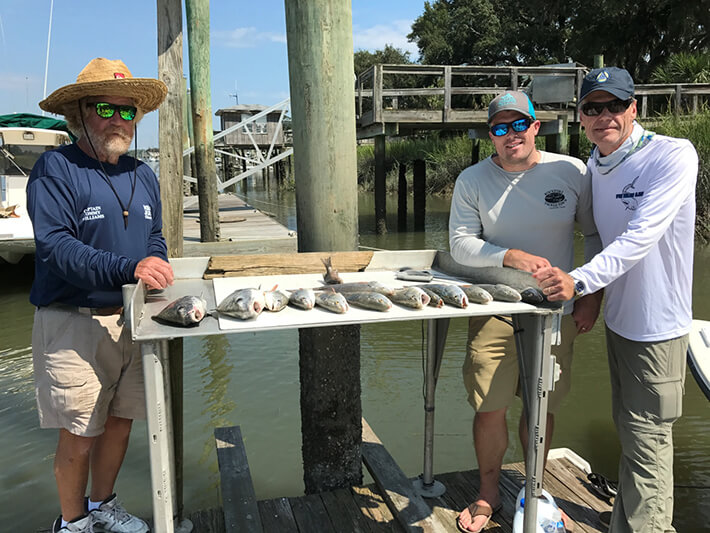
While inshore fishing with Captain Tommy Williams of Miss Judy Charters Eric Larson and his visiting son Andrew had a pretty darn good day of catching! Who caught the biggest fish? Eric what did they use for bait? Live and dead shrimp Who told the biggest fish tale? Andrew And what tale was that? Andrew let his father Eric catch the biggest fish. It was his plan way before they left the dock!
Welcome to Barracuda-Ville!
Miss Judy Too takes charge and makes all the right fish calls!
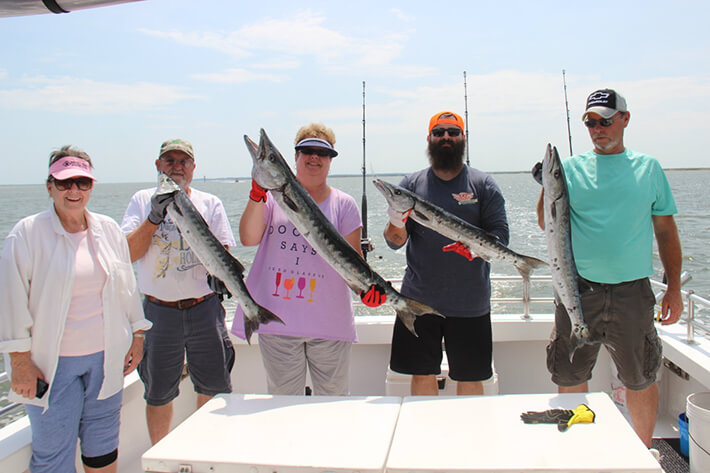
I love taking groups that just want to go fishing and just want to catch whatever bites their line. With water temps so warm the artificial reefs located in around 55 feet of water are still not holding much in the way of bottom fish. So therefore trolling was our only option for catching and keeping. Yes, we could have practiced “catch and release” while bottom fishing, but we decided to go the top water fishing route. While pulling 0/00 Clark spoons behind various planers from #1 to #2 to #3 sizes we mangled to catch a few Spanish and king mackerel. But here’s the thing, trying to get a whole mackerel in before the barracuda ate what they wanted was not too doable. So therefore we turned out sites on the toothy monsters. Believe me we were not disappointed. These fish put on an amazing above water display. While doing what barracuda do once hooked up, which involves quite a bit of acrobatic tumbling and swinging without the aid of a trapeze, our fishing team were simply amazed. I have to admit and as you know I have been doing this a long time, I still get amazed at this fish’s coordination. By the way we still are offering barracuda trips and normally these toothy monster stay around until first of December! So if want to try and catch a fish that does as much swimming as it does trying to fly, you still have time!
And then there is the question that is always asked especially if it is your first time…Is barracuda meat good to eat? While my standard answer is “Our customers have been eating barracuda for as long as I can remember;” how do they fix it? They treat it like any other fish. You can soak it in anything from buttermilk to Italian dressing. You can rub any kind of seasoning on it. You can fry it, bake it, or grill it and once cooked..what do you have? White flakey meat! I think you get the picture! And here’s the best news, if you don’t want it I have lots of people that would be happy to come over and pick it up! So if you don’t want to eat it, it will not waste, and you still get to get a great strong fish fight!
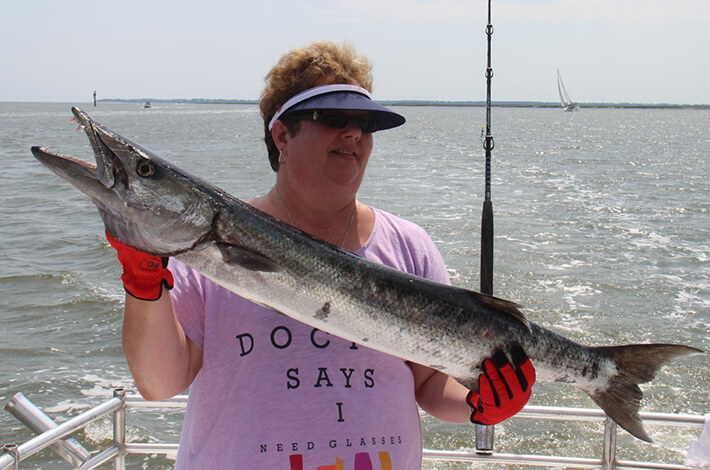
Check out this barracuda’s mouth! As you can see they are sporting a set of teeth that is capable of doable quite a bit of damage to their prey. See the hole in the top of the inside of the barracuda’s mouth? Well, when this fish is swimming behind your bait with the intentions of making some sort of striking move water rushes through this hole producing what is better

Savannah Snapper Banks!!
Wendy Clark and Captain Ryan Howard of Miss Judy Charters took a busman’s holiday!
What is a busman’s fishing holiday? It is period of holiday or leisure time spent doing something similar to one normal occupation! Captain Ryan Howard of Miss Judy Charters loves to go and take people charter fishing. And here’s the thing Captain Ryan is not just fishing he is catching! (Before Hurricane Irma)
While fishing with Captain Ryan Howard of Miss Judy Charters Wendy Clark shows us exactly two fishermen can do with a rod, reel, and loaded hooks in their hand. What do we have here? I am going to call this a Savannah Offshore Ocean Top Water Slam! They caught Wahoo, dolphin, king mackerel! How did they do this? While plain old bottom fishing with assorted baits they caught vermilion snapper, black sea bass, trigger fish, as well as other biters. While making long drifts, Captain Ryan put out his deadly top water flat line. And they caught Wahoo, dolphin, and mackerel! What was using for bait? A live porgy rigged on king rig!
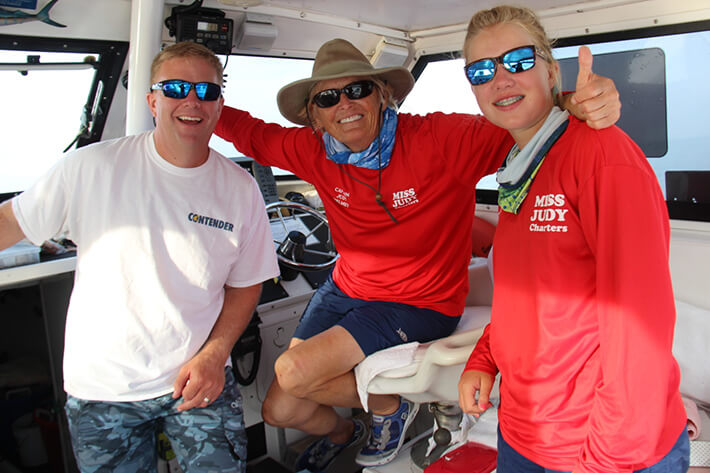
Daughter Father Gulf Stream Overnight Trip! Was it a success? You bet! – By Alli DeYoung, Contributing Editor!
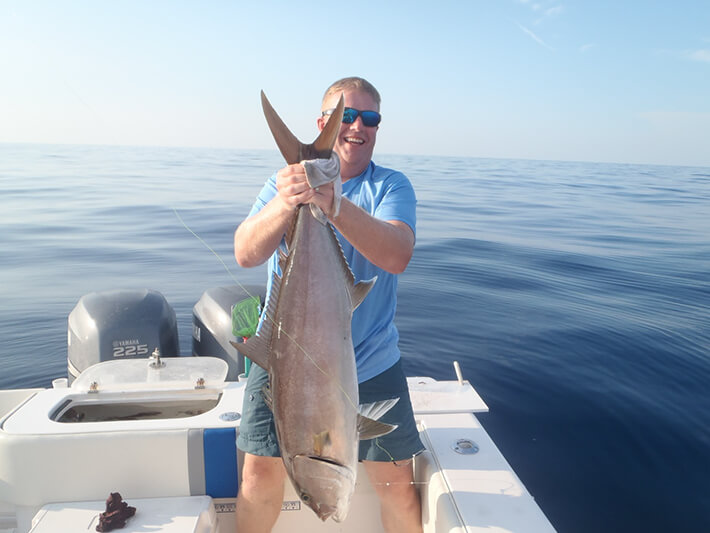
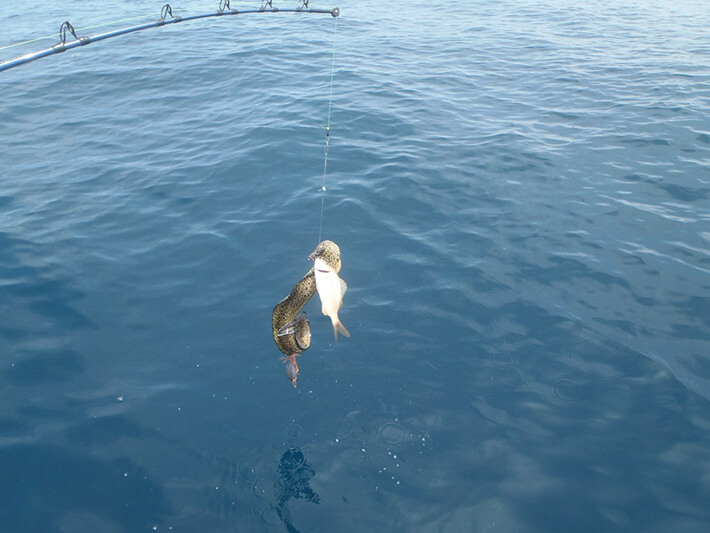
Due to the beautiful weather, Labor Day weekend, Daddy and I took the chance to go on an overnight fishing trip. We left the dock at 7:30 am on September third to start our adventure. We stopped in the sound to get a cast net full of Menhaden and then continued on to the artificial reefs to get some Greenies and Spanish Sardines. We could not find a school of bait on the surface so we dropped to the bottom, but they were being super skittish because of the amount of Barracuda around them. So, with the excitement of 2 days of fishing ahead of us we decided to just go fish. It was super smooth so we went to the Bee-liner Hole. We made a few drops and caught some triggerfish. Then we thought daddy got a nice bite, however when he got it to the surface it was a Moray Eel. After a good look at his teeth, and his flexibility, we knew we needed to be careful on how we handled him. He tied himself into a knot and we were able to get our rig back. I later learned that eel’s will tie themselves into a knot and then slide the knot up their body to try to spit out the hook.
On our way to another spot we saw a floating wood pallet and of course we had to check it out. Under the pallet were some triple tail and a big school
of feisty Banded Rudderfish. I tried to pitch some squid to the tripletail, but the Banded Rudderfish got to it first every time, so we moved on.
We came to a bunch of birds working an area so we trolled some lures in search of a King Mackerel, but only found little tunny. Then we continued to our spot and caught Strawberry Grouper, Triggerfish, Pink Porgies and Bee-liners. Once the sun started to set, we made the call to head in to M2R6 to set up camp. It was a beautiful night with a light breeze and a full moon. It is an amazing feeling to see all of the stars in the sky while being all by ourselves so far away from home. I wish there was a way to duplicate the feel of falling asleep as the sound of water lapping against the gently rocking boat, and a slight ocean breeze, because I would love to fall asleep like that every night. We traded off sleeping all night for safety reasons.
I woke up to a beautiful sunrise and got ready for a second day of fishing fun. We headed back out to the Bee-liner Hole, got set up and caught some more Triggerfish, Pink Porgies, and Bee-liners. Then daddy got a huge bite. He fought it for some time to get it to the surface and we saw that it was a massive Amberjack. As we looked into the clear water we could see a huge Tiger shark coming straight up from the depths with his eye on the Amberjack. Daddy and I both agreed that the shark had to at least be ten feet long. Before we could grab the camera for a picture the shark was gone, but the Amberjack was still there. As I held the line Daddy grabbed the tail and heaved it over the gunnel. After taking pictures of this big Amberjack, we released him unharmed back to the wild.

On our way home, we cut through the Savannah Snapper Banks to get some more Bee-liners. It is always great to go fishing but it is even better when I get to have trips with just daddy.
We had a great trip that concluded with one Moray Eel, one Strawberry Grouper, six Pink Porgies, ten Vermillion Snapper, twelve triggerfish, and one Amberjack. The Bee-liner Hole never fails to deliver a great day!
Little Miss Judy Believe it or Not!
This looks like a floating discarded pallet, but maybe not!
Captain Ryan Howard of Miss Judy Charters and Wendy Clark were doing a little bottom fishing in about 105 feet and they came across this floating goldmine! While live lining near this pallet they caught a nice Yahoo Wahoo, a couple of dolphin also known as Mahi Mahi, and a king mackerel. This was a great catching line up for such a small float object. However, please read on and you will know the why!
What is this? I know what you must be thinking, it’s a pallet, and what’s the big deal? However, once this pallet also known as flotsam/jetsam was admitted to the water, it became one heck of a target rich environment for all size fishes as well as fishermen. I used to say the phase “flotsam/jetsam” all of the time. And then many years ago I decided to find out exactly what these words exactly meant! So I went to the old paperback Webster dictionary. Flotsam is defined as debris that was not deliberately thrown overboard often a result from of a shipwreck or accident. Jetsam describes debris that was deliberately thrown overboard by a crew maybe from a ship in distress, most often to lighten the ship’s load.
Now this is where it gets important… under maritime law the distinction is important. Flotsam may be claimed by the original owner, whereas jetsam may be claimed as property of whoever discovers it. If the jetsam is valuable, the picker-upper may collect proceeds received though the sale of the salvaged objects. So this pallet as far as I am concerned was not thrown overboard on purpose and most likely would fall under the title of flotsam. It really doesn’t have any value out of the water, but it certainly does in it. Why? Small fish school around it and larger fish know it! And this is where the saying, “There is always a bigger fish in the sea!” came from!
Thanks for reading! – Captain Judy
Captain Judy Helmey
Miss Judy Charters
Kicking Fish Tail Since 1956!
124 Palmetto Drive
Savannah, Georgia 31410
(912)-897-4921 or (912)-897-2478
(912)-897-3460 fax
fishjudy2@aol.com
